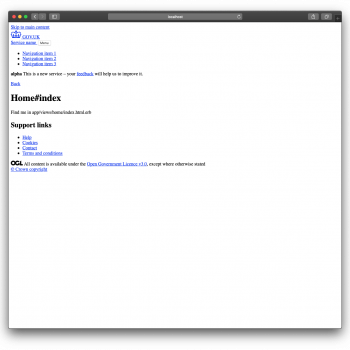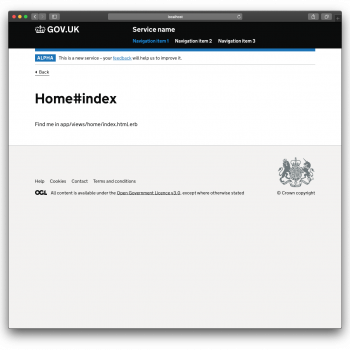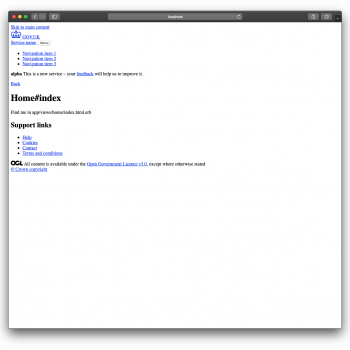When Rails met the GOV.UK Frontend…

The GOV.UK Frontend can be loaded with Webpacker without too much effort
I love working with Rails and the GOV.UK Frontend (the implementation of the GOV.UK Design system) and have built lots of services with them. Although it hasn’t always been smooth sailing for them as a couple.
With the release of Rails 6, I was keen to see whether using Webpacker (enabled by default in Rails 6) would make the relationship any smoother.
Webpacker is ‘Webpack the Rails way’. Which to me, means a clever, opinionated and sensible default setup of Webpack integrated into Rails. There was a nice intro to Webpacker at RailsConf 2019 that is worth a watch
I thought it would be interesting to share my experience of getting the GOV.UK Frontend into Rails 6 using Webpacker. Bear in mind, this is neither the definitive way to achieve this goal or a full blown tutorial!
Let’s get a fresh Rails project, we’ll skip some of the components we won’t need, like Sprockets, we’ll call it ‘rails-and-govuk-frontend’:
rails new --skip-sprockets --skip-action-cable --skip-active-storage rails-and-govuk-frontendInside our new project, let’s get a controller and a view to work with:
rails generate controller Home index --no-assets --no-helperAnd set the view to the root of the site by updating the routes file:
config/routes.rbroot 'home#index'
Next we want the GOV.UK page template as our application layout, we’ll use the template from here and include a couple of Rails parts, there is a lot here so here is the file:
app/views/layout/application.html.erb
We’ll add some css classes in our view so we can see when things are working:
We also want the GOV.UK Frontend package, which we get with yarn:
yarn add govuk-frontendRunning the application now we get this:

Hmmm, not a great looking service, but it is the basics we need, now we need to wire things up.
Webpacker in Rails uses the idea of ‘packs’. Our aim is to make a pack that contains all the things we need from the GOV.UK Frontend: the styles, JavaScript, images, fonts, etc.
These packs live in the new javascript directory inside our Rails project. We’ll call our pack govuk:
app/javascript/packs/govuk.jsWe also need some control over how the GOV.UK Frontend styles will get compiled. To do this we’ll make a Sass file which sets things up and then loads all the GOV.UK styles.
In this brave new Webpacker world all the assets are loaded via JavaScript (via Webpack), but don’t panic, only in the build process, our service will still work for users without JavaScript. Because of this we keep all the components of our pack together in the new javascript/packs directory.
I know it’s a little odd to store assets in the javascript directory but we are following convention over configuration here!
Let’s create our Sass file:
app/javascript/packs/stylesheets/govuk.scssIn this file, we’ll set a variable the GOV.UK styles uses internally and then import them like so:
$govuk-assets-path: "~govuk-frontend/govuk/assets/";
@import "govuk-frontend/govuk/all";The $govuk-assets-path tells Sass where to load the images and fonts that are used in the styles from govuk-frontend/govuk/assets/, the ~ tells Sass to look in the node_modules directory and internally the GOVUK Sass will add either images or fonts to set the paths correctly.
Next a standard @import brings all the GOV.UK styles into our file. Here all contains every GOV.UK component, but we could load only the components we need at this point if we wanted even finer control.
There are also other options we could set, see the GOV.UK Frontend settings for more info.
Now we need to load the GOV.UK JavaScript, import our Sass file and add any assets that are not loaded from the styles, which include things like the favicon, Open Graph image and more.
To do this we require them into our pack, remember everything is loaded via JavaScript so it goes into:
app/javascript/packs/govuk.jsrequire("govuk-frontend/govuk/all").initAll()
require.context('govuk-frontend/govuk/assets/images', true)
import "./stylesheets/govuk.scss"The first line grabs the GOV.UK JavaScript and calls initAll() on it, which is a function in the GOV.UK Frontend that initialises all the components on the page.
require.context is a Webpack method to add a whole directory of dependencies which we use here to load all the other images from the GOV.UK Frontend package.
Lastly we import the stylesheet we just created.
Out application now has two packs ‘application’ and ‘govuk’, but it’s not using them, let’s change that…
We use the javascript_pack_tag helper to load the JavaScript packs into our application layout.
The application pack can go in the <head></head>, but the GOV.UK JavaScript (and so our pack) must be loaded at the end of the document so we add that before the closing body tag.
We also use the stylesheet_pack_tag helper to load the styles from our govuk pack back in the <head></head> again.
We also use the stylesheet_pack_tag helper to load the styles from our govuk pack back in the <head></head> again.
<%= stylesheet_pack_tag 'govuk', 'data-turbolinks-track': 'reload' %>
…
<%= javascript_pack_tag 'govuk', 'data-turbolinks-track': 'reload' %>
See the complete file:
app/views/layouts/application.html.erb
Now we have everything loaded we just need to update the static assets in our layout, there are quite a few, but essentially any url to an asset should be replaced with:
<%= asset_pack_url('media/images/filename-of-the-asset') %>The ‘media’ part of the url is really important as it is added by Webpacker before each asset path. Once we bundle our packs, looking in public at the Rails project root you should see public/packs/media/images and public/packs/media/fonts populated with the assets.
Here’s the complete layout with static asset paths:
app/views/layout/application.html.erb
Let’s see where we are, we need to run web packer to bundle all the assets into the pack:
bin/webpackOr we can automatically bundle every time there is a change with:
bin/webpack-dev-server(There is more to the webpack-dev-server than this, but that’s another story.)
And running the application now we get this:

Looks great, but there is a problem that isn’t obvious, all the styles are loaded into our JavaScript so users without JavaScript cannot see them! 🙁
To prove it here is our service with JavaScript disabled:
We should always consider styles and JavaScript progressive enhancement so let’s get this fixed.

To get the styles as a separate file that doesn’t need JavaScript to load it we can change the default behaviour in Webpacker:
extract_css: trueAfter restarting webpack-dev-server or running webpack and re-starting our Rails server, our styles come as a separate css file and load without JavaScript, we had to restart Rails because we made a configuration change.
By default Webpacker only uses this ‘styles in JavaScript’ approach in the development and test environments, so production, or our real live service, would have been okay, but I feel like I want all three environments to work the same way regardless.
And that is it, I’m pretty happy to see that the GOV.UK Frontend can be loaded with Webpacker without too much effort, once I got the idea of the packs I think it’s a little simpler than using the asset pipeline. The approach I use with the asset pipeline means listing all the GOV.UK static assets out which feels a little bit brittle to changes.
I like that this also makes managing the dependency the our application has on the GOV.UK Frontend super easy, we can just use yarn to update the package or lock it to a specific version for example.
There we go, it’s no When Harry met Sally… but I think it’s still a pretty good love story.
If you have questions or comments, please get in touch and have a lovely Valentine’s Day!